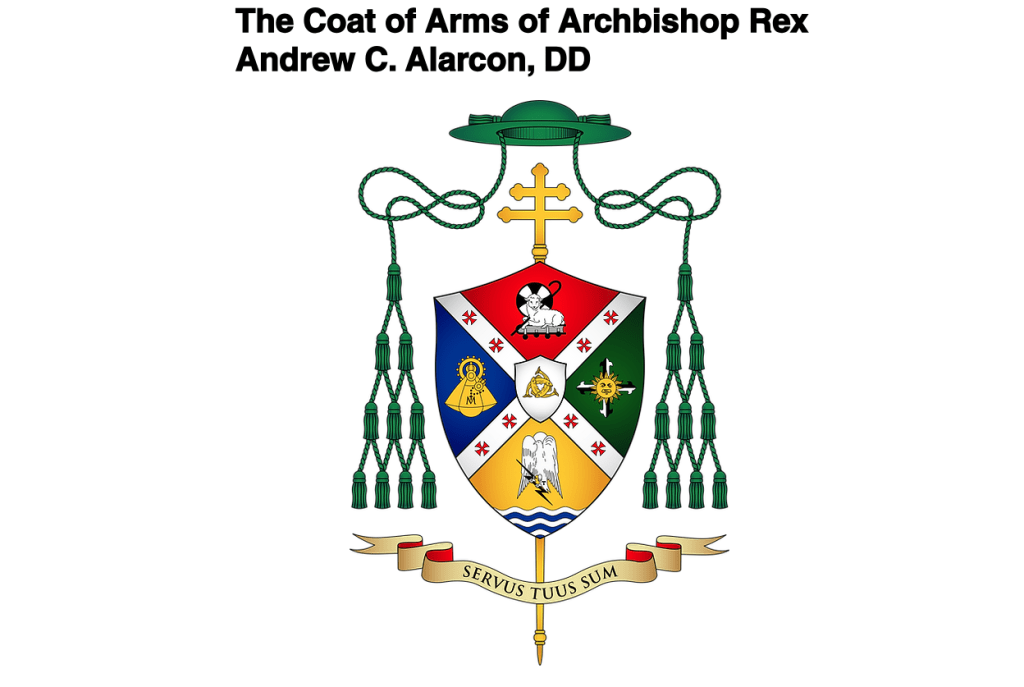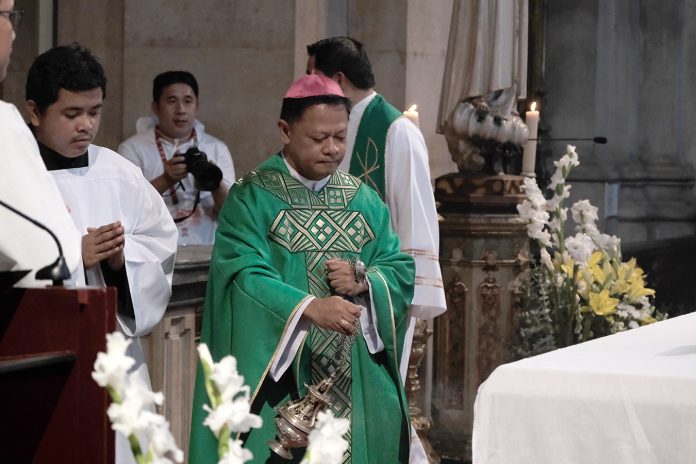The Catholic Church in Naga City in the Bicol region has released the official coat of arms of Rex Andrew C. Alarcon, the 35th Bishop and 5th Archbishop of Caceres.
Marking documents is the most common use of a Church leader’s coat of arms.
In olden times, a Catholic bishop’s coat of arms was usually painted on miniature wine barrels and presented during the ordination ceremony.
The coat of arms carries symbols that pertain to the life and ministry of a bishop as a shepherd in the local Church.
The Solemn Installation and Canonical Possession of Archbishop Alarcon will be held on May 2, at the Naga Metropolitan Cathedral.
Here are the meanings of the symbols on Archbishop Alarcon’s coat of arms:

EPISCOPAL MOTTO (Sable [black] text on Or [gold] Banner)
SERVUS TUUS SUM. I am Your Servant. The Archbishop’s motto is inspired by Mary’s response to the angel Gabriel at the Annunciation and by Jesus’ instruction to the disciples, to wit:
“I am the handmaid of the Lord” (Luke 1, 38)
So, you also, when you have done everything you were told to do, should say, ‘
We are unworthy servants; we have only done our duty.’” (Luke 17, 9-10)
Other scriptural inspirations are:
“The greatest among you become as the youngest,
and the leader as the servant.” (Luke 22, 26);
“I have come not to be served but to serve.” (Matther 20, 28);
“Now that I, your Lord and Teacher, have washed your feet,
you also should wash one another’s feet.” (John 13:14).
‘Tuus’ (Your), referring to Jesus, expresses the conviction a bishop’s life and ministry find meaning and fulfillment through, with and in Jesus, the Master. Among the Archbishop’s preferred counsels is “We are workers, not master builders.” ‘Sum’ (I am) indicates willingness to serve.
The motto is a prayer for the Archbishop: that his life and ministry be infused with Mary’s availablity (disponibilité) and Jesus’ self-offering (kenosis), so that the underserved grace of serving God and his people be sustained in him.
HERALDIC DESCRIPTION (Blazon)
Per saltire (X – crosswise) in Argent (silver) with eight small Crosses in Gules (red); Chief point in Gules (red), with the Lamb of God with staff on the Sacred Scriptures with four markers in Argent and Sable (silver and black); Sinister flank in Azure (blue), with the Icon of Inâ, Our Lady of Peñafrancia in Or (Gold) and with a rosary and letter ‘M’ on the icon in Sable (black); Dexter flank in Vert (green) with a sun with twelve rays in Or (gold) over a Dominican Cross in Argent and Sable (silver and black), Base point in Or (gold) with a nimbed eagle in Argent (silver) above waves in Azure and Argent (blue and silver); At center, a smaller shield in Argent with three fishes in Or (gold).
EXPLANATION OF THE CHARGES IN THE COAT OF ARMS
CHIEF POINT (Upper)
AGNUS DEI WITH PASTORAL STAFF, ON SACRED SCRIPTURES. The Agnus Dei represents Jesus, the ‘Messiah-the Suffering-Servant’. Jesus is King (Rex) and High Priest —the offeror (sacrificare –to offer sacrifice) and the victim (sacrificari –to be sacrificed) on the cross. The clement Lamb a reminder of God’s mercy.
The Lamb is also associated with St. John the Baptist, who pointed to Jesus as the ‘Lamb of God —Agnus Dei (cf. John 1, 29). St. John, who said: “He must increase, I must decrease,” is the patron of the Parish in Daet, Camarines Norte, where the Archbishop was baptized and confirmed. Daet is his birthplace.
The Pastoral Staff represents the Good Shepherd, whom the Archbishop is called to imitate; a reminder that his ministry is of humble service rather than lording over; care than honor; stewardship than ownership; going to peripheries than simply maintenance; self-giving than self-preservation.
The Sacred Scriptures represents Jesus, the Word made flesh, whom the Archbishop strives to give witness to. Jesus is the incarnate Word who, not self-referential, sends disciple-missionaries for evangelization. The four markers represent the four Evangelists: Matthew, Mark, Luke and John.
The aforementioned images symbolize the three offices of a Bishop, namely: to sanctify —Sanctificandi (Lamb), to govern —Governandi (Staff) and to teach —Docendi (Sacred Scriptures).
SINISTER FLANK (Left)
ICON OF INÂ, OUR LADY OF PEÑAFRANCIA. The icon of Inâ signifies the Archbishop’s devotion to the Blessed Virgin Mary, and her significant role in his journey to the priesthood. He started as a seminarian under the Parish of Our Lady of Peñafrancia, and ordained a deacon and priest under the Parish of the Immaculate Conception, both in Naga City.
The crown of the Virgin marks the year of the Archbishop’s appointment to Caceres, 2024, the Centennial year of the Canonical Coronation of Our Lady of Peñafrancia.
On closer look, the icon bears a rosary, symbolizing the Lady of the Holy Rosary, the patroness of the Holy Rosary Minor and College Seminary, as well as the UST Central Seminary where the Archbishop had his initial formation for the priesthood.
The letter ‘M’ represents St. John Paul II, who was totally devoted to the Virgin (Totus Tuus) and to whom the Archbishop has a special devotion, especially because of his visit to the Philippines and the Central Seminary in 1995 for the World Youth Day. 1995 was also the 400th year of the establishment of Caceres (1595).
DEXTER FLANK (Right)
SUN AND DOMINICAN CROSS. The Sun represents St. Thomas Aquinas, patron of Catholic Education and of the seminaries and schools where the Archbishop obtained his formation: the Naga Parochial School, Holy Rosary Minor and College Seminary, the University of Santo Tomas Central Seminary and Ecclesiastical Faculties, and the Pontifical Gregorian University. In his pastoral assignments, St. Thomas has always been an inspiration.
The same Sun, with a smiling face, represents the Youth, as he was named bishop on the Year of the Youth in the Philippines, 2019.
The Dominican Cross pays homage to St. Dominic of Guzman, and to his mentors and teachers, and especially to former Ordinaries of Caceres, +Francisco Gainza, OP and +Leonardo Z. Legaspi, OP.
BASE POINT (Lower)
NIMBED EAGLE. The Eagle, presented as nimbed or one with an aureole, represents St. John the Evangelist and the Archdiocese of Caceres. Its feet hold a thunderbolt, alluding to the nickname ‘boanerges’ which was given by Christ to St. John and his brother James, meaning ‘Sons of Thunder.’
St. John the Evangelist is the Titular of the Metropolitan Cathedral in Naga, where the Archbishop spent most of his years in the priestly ministry. St. John is also the Patron of the Naga Parochial School, where he was Director prior to his election to the Episcopacy.
THE TAU CROSS. The minuscule Tau cross on the feathers of the eagle is symbolic of St. Francis, the model of the Franciscans and Pope Francis. The then-Diocesis de Nueva Caceres was, for a long time, under the Franciscan Missionaries, among whom was St. Pedro Bautista —Titular Patron of the Archdiocese of Caceres. The same Tau cross also signifies unity with Pope Francis, who appointed the Archbishop. The cross is hardly visible like the signatures of Pope Francis.
WAVES. The waves represent Caramoan, the provenance of his family —both father and mother side.
INESCUTCHEON (Center)
THREE FISHES. The three intertwined fishes are an ancient symbol for the Holy Trinity —one God, three Divine Persons: the Father, the Son and the Spirit. These also represent the Diocese of Daet, where the Archbishop was first assigned as its fourth ordinary from 2019-2024. The Trinity is at the very center of the coat indicating the centrality of the Holy Trinity in the life and ministry of the Archbishop.
The Most Holy Trinity is the source and model of Synodality —communion, participation and mission. The Archbishop prays that his ministry may respond to the call of Pope Francis towards a more synodal Church.
DIVISIONS, TINCTURES AND EMBELLISHMENTS
PER SALTIRE (diagonal cross with four divisions). The ‘X’ division of the shield represents the Cross (crux decussata) of St. ANDREW, the ‘namesake’ of the Archbishop. St. Andrew accepted the call to be a ‘fisher of men’ after John pointed to Jesus as the ‘Lamb of God’ (John 1, 35-41). On his martyrdom, he considered himself ‘unworthy to be crucified on the same type of cross as Jesus.’
The Argent (silver) field with eight crosses in Gules (red) is adapted from the Alarcon Coat of Arms. Incidentally, the dexter and sinister flanks in Azure (blue) and Vert (green) appear like wings —‘con alar’ (with a wing), the Archbishop’s family name.
TINCTURES (Colors) AND EMBELLISHMENTS. The fields are colored Gules (red), Azure (blue), Vert (green) and Or (gold).
Gules (red) symbolizes the martyrdom of St. Andrew, St. John the Baptist, St. Pedro Bautista, and Jesus Christ —the Lamb of God. It also symbolizes courage, service and love.
Vert (green) represents St. Joseph, a hidden yet obedient, silent yet diligent, tender yet courageous father, on whose Solemnity — March 19 — the Archbishop was ordained to the Episcopacy. Green also symbolizes life and hope.
Or (gold) symbolizes divinity, wisdom and grace.
Azure (blue) symbolizes faith, patience and creativity.
Sable (black) and Argent (silver) symbolize humanity, humility and truth.
THE PROCESSIONAL CROSS AND GALERO with twenty tassels indicate the hierarchical rank of the bishop. Vert (green) is the heraldic color for the galero and tassels of the Archbishop.
The style of the Cross is taken from the Coat of Arms of +Pedro Paulo Santos. The style of the Galero is taken from the Coat of Arms of +Leonardo Z. Legaspi, OP.









